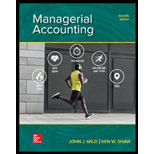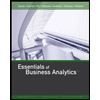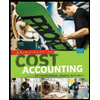
Concept introduction:
Cycle efficiency:
Cycle efficiency denotes about the use of cycle time in value-added activities. In other words, we can say that cycle efficiency shows relationship between value-added time and cycle time. On the basis of cycle efficiency we know about the use of whole cycle time in the value-added activities.
Requirement 1:
Non-value-added time under the traditional manufacturing process.
Answer to Problem 3P
Explanation of Solution
Concept introduction:
Cycle efficiency:
Cycle efficiency denotes about the use of cycle time in value-added activities. In other words, we can say that cycle efficiency shows relationship between value-added time and cycle time. On the basis of cycle efficiency, we know about the use of whole cycle time in the value-added activities.
Requirement 2:
Cycle efficiency under the traditional manufacturing process.
Answer to Problem 3P
Explanation of Solution
Concept introduction:
Cycle efficiency:
Cycle efficiency denotes about the use of cycle time in value-added activities. In other words, we can say that cycle efficiency shows relationship between value-added time and cycle time. On the basis of cycle efficiency, we know about the use of whole cycle time in the value-added activities.
Requirement 3:
Non-value-added time under the proposed lean manufacturing process.
Answer to Problem 3P
Explanation of Solution
Concept introduction:
Cycle efficiency:
Cycle efficiency denotes about the use of cycle time in value-added activities. In other words, we can say that cycle efficiency shows relationship between value-added time and cycle time. On the basis of cycle efficiency, we know about the use of whole cycle time in the value-added activities.
Requirement 4:
Cycle efficiency under the proposed lean manufacturing process.
Answer to Problem 3P
Explanation of Solution
Concept introduction:
Cycle efficiency:
Cycle efficiency denotes about the use of cycle time in value-added activities. In other words, we can say that cycle efficiency shows relationship between value-added time and cycle time. On the basis of cycle efficiency we know about the use of whole cycle time in the value-added activities.
Requirement 5:
Would the proposed lean approach improve cycle efficiency?
Answer to Problem 3P
Yes, the proposed lean approach would improve cycle efficiency.
Explanation of Solution
Want to see more full solutions like this?
Chapter C Solutions
Managerial Accounting (Looseleaf)
- I need guidance with this general accounting problem using the right accounting principles.arrow_forwardI am searching for the accurate solution to this accounting problem with the right approach.arrow_forwardPlease provide the accurate answer to this general accounting problem using valid techniques.arrow_forward
- Upon completing an aging analysis of accounts receivable, the accountant for Stevens Manufacturing prepared an aging of accounts receivable and estimated that $8,500 of the $142,300 accounts receivable balance would be uncollectible. The allowance for doubtful accounts had a $430 credit balance at year-end prior to adjustment. How much is the bad debt expense?arrow_forwardI am searching for the accurate solution to this financial accounting problem with the right approach.arrow_forwardWhat purpose does transactional layering serve?arrow_forward
 Cornerstones of Cost Management (Cornerstones Ser...AccountingISBN:9781305970663Author:Don R. Hansen, Maryanne M. MowenPublisher:Cengage Learning
Cornerstones of Cost Management (Cornerstones Ser...AccountingISBN:9781305970663Author:Don R. Hansen, Maryanne M. MowenPublisher:Cengage Learning Managerial Accounting: The Cornerstone of Busines...AccountingISBN:9781337115773Author:Maryanne M. Mowen, Don R. Hansen, Dan L. HeitgerPublisher:Cengage Learning
Managerial Accounting: The Cornerstone of Busines...AccountingISBN:9781337115773Author:Maryanne M. Mowen, Don R. Hansen, Dan L. HeitgerPublisher:Cengage Learning Excel Applications for Accounting PrinciplesAccountingISBN:9781111581565Author:Gaylord N. SmithPublisher:Cengage Learning
Excel Applications for Accounting PrinciplesAccountingISBN:9781111581565Author:Gaylord N. SmithPublisher:Cengage Learning Managerial AccountingAccountingISBN:9781337912020Author:Carl Warren, Ph.d. Cma William B. TaylerPublisher:South-Western College Pub
Managerial AccountingAccountingISBN:9781337912020Author:Carl Warren, Ph.d. Cma William B. TaylerPublisher:South-Western College Pub Essentials of Business Analytics (MindTap Course ...StatisticsISBN:9781305627734Author:Jeffrey D. Camm, James J. Cochran, Michael J. Fry, Jeffrey W. Ohlmann, David R. AndersonPublisher:Cengage Learning
Essentials of Business Analytics (MindTap Course ...StatisticsISBN:9781305627734Author:Jeffrey D. Camm, James J. Cochran, Michael J. Fry, Jeffrey W. Ohlmann, David R. AndersonPublisher:Cengage Learning Principles of Cost AccountingAccountingISBN:9781305087408Author:Edward J. Vanderbeck, Maria R. MitchellPublisher:Cengage Learning
Principles of Cost AccountingAccountingISBN:9781305087408Author:Edward J. Vanderbeck, Maria R. MitchellPublisher:Cengage Learning





